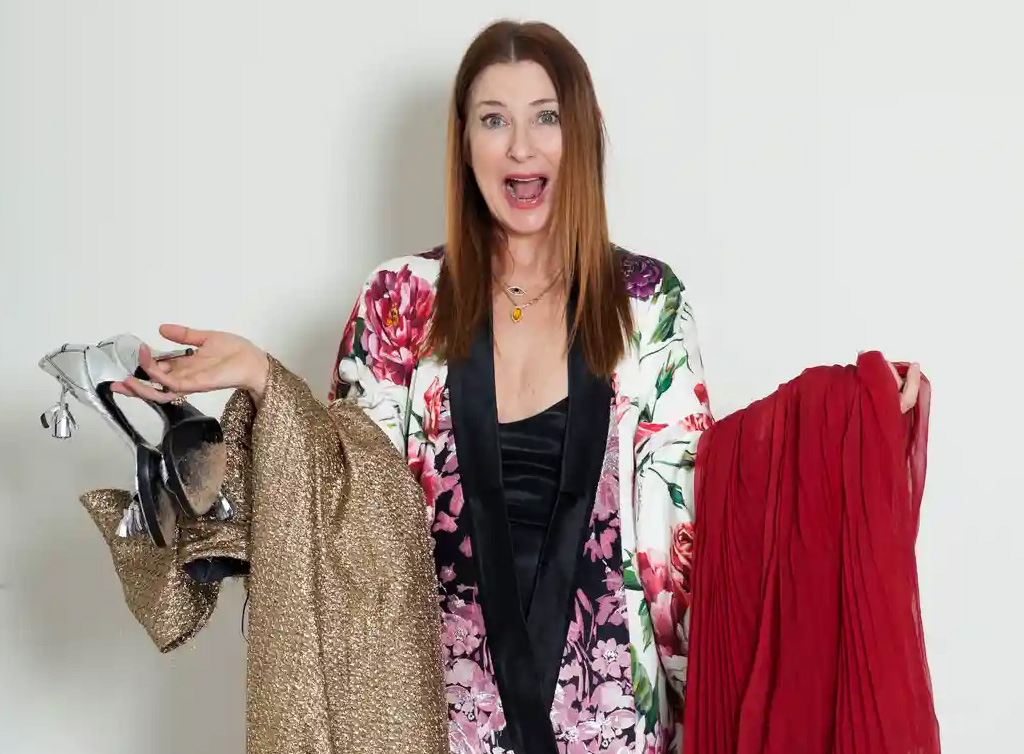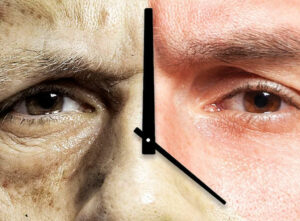How do our clothes affect our mood? Sharon Walker delves into her wardrobe with fashion psychologist Dawnn Karen and finds a poignant explanation for her love of party dresses.
Friday night, 11pm. I am snapping a selfie in the bedroom mirror. Not for Instagram I hasten to add – no one over 40 should do that – but for my “Best Dressed” folder of outfits. Next to me on a chair is a mountain of clothes that have been lying fallow in my wardrobe for more than a year. Some haven’t seen the light of day for as much as a decade. I must wear them all within a week or drag them kicking and screaming to the charity shop. This is all part of a Radical Wardrobe Edit that I’m racing to complete, as decreed by Dawnn Karen, a fashion psychologist, whose new book Dress Your Best Life promises to “harness the power of clothes to transform your life”.
The “new” outfits I’ve unearthed from this growing pile are pinging me pleasing little hits of dopamine, delivering the kind of euphoric high I might ordinarily experience on the Ganni website, but the thought of jettisoning a silver vintage dress brings me out in a cold sweat, even though I know there’s no chance I’ll ever again fit into it and would, in any case, rarely have an occasion to wear it.
What lies behind this unnatural attachment? I’m about to find out as I’ve booked a fashion therapy session with Karen who, though based in New York, is available to deal with wardrobe hang-ups from afar by phone or FaceTime.
Fortunately, when Karen pops up on my phone screen radiating a joyous positivity, all worries of a brutal wardrobe cull quickly evaporate. Less draconian stylist, more softly-softly wardrobe whisperer, Karen is the salve for all your fashion anxieties, whether you’re looking to revive your sartorial swagger after a heartbreaking divorce or wrestling with your body image. Or perhaps, like me, you’ve hit midlife and simply need coaxing out of a style rut.
“I’m not the type to tell you what to wear; I can get a little prescriptive, but only after you’ve told me who you are,” she tells me. “And I’m not going to tell you, ‘You must get rid of this dress you love.’ But if we had more sessions, I would unpack why you’re holding on to it,” she tells me.
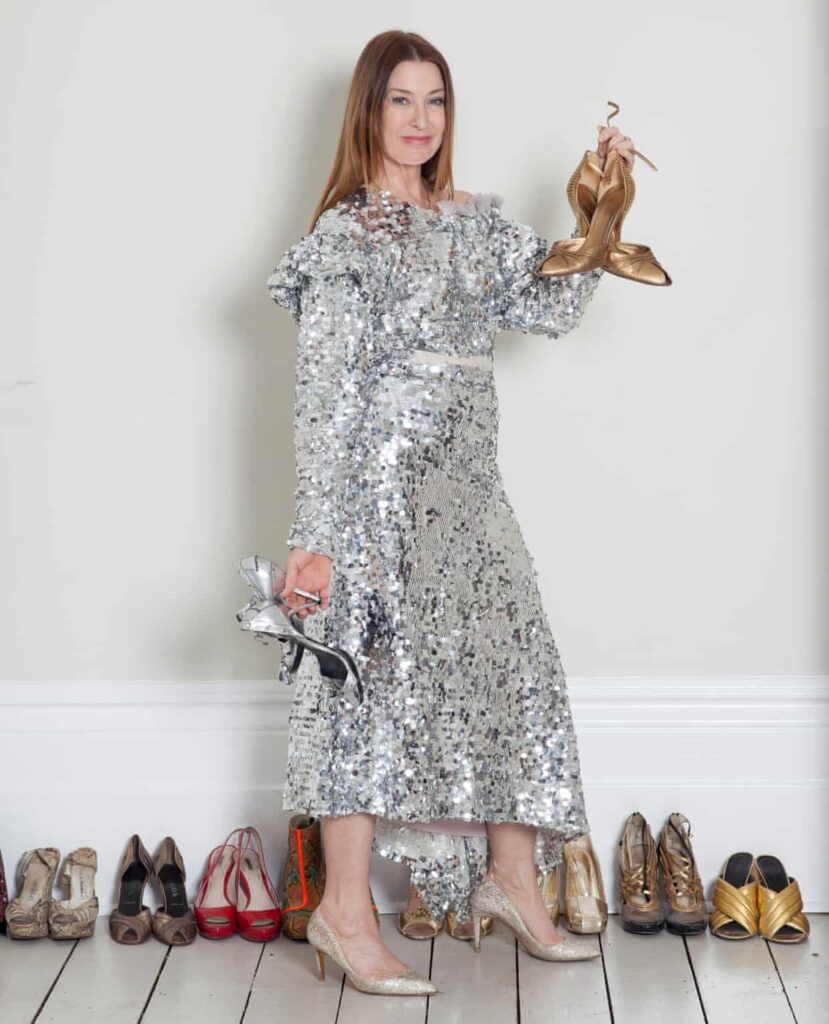
Not to be confused with a personal shopper, who will prescribe a “look” and likely persuade you to invest in a heap of new outfits, Karen is a qualified therapist with a master’s degree in counselling psychology from Columbia University. And if you haven’t heard of the role of fashion psychologist before now, that’s because Karen, 31, invented it. It does seem like the perfect marriage of her skill sets. A former model with a lifelong passion for clothes, she is the first black female psychology professor at the Fashion Institute of Technology in New York. So Karen knows fashion. But she is also sceptical of “style rules, flash-in-the-pan trends and paint-by-numbers styling advice”. Her sessions are designed to gently tease out what clothes mean to you and look at how you can use them to feel more confident, calm or powerful. In other words, fashion as therapy or “styling from the inside out”, as she calls it.
As you might expect from a fashion psychologist, Karen is exquisitely turned out, in a chic black top (everyone should have two of these wardrobe basics), with long glossy black hair. Her personal fashion “brand”, something we should all have, she says, is minimalist glam, which means statement capes, bold colours, leopard print (“It’s practically a neutral for me”) and towering heels, as you can see on her Instagram account.
Before we start, she makes the point that she normally spends three sessions getting to know her clients before she even looks at their wardrobe, but for the purpose of this interview we will dive straight into my closet.
Like many of her clients – at least those who aren’t in the public eye – I’m at a transitional stage in my life; one that I’m not sure my current wardrobe suits.
I’ve hit my mid-50s, my kids are about to fly the nest, but my wardrobe tells a different story. I am, and I’m almost embarrassed to admit this, something of a sequin addict. And not just sequins. My wardrobe is bursting with silver lamé, silks, satins, flowing lace and plentiful gold pleats. If it twinkles like a disco ball or says “party”, I must have it. I have 40 pairs of shoes, few of which I can walk in, and dresses… so many dresses. Essentially, I have the wardrobe of a fabulous fashionista at a permanent cocktail party, whereas in reality I am a 54-year-old mother of two who works from home in jeans and trainers. When I have a work meeting I panic and reach for the same boring black dress. It’s a serious case of fashion dissonance.
Karen might conclude that I have a “Repetitious Wardrobe Complex” and I wonder if it’s something I should strive to fix. I know from her book that I’m far from alone in shopping for a fantasy life. It’s a common affliction among her clients and the reason so many of us peer into a wardrobe bursting at the seams, only to wail, “But I have nothing to wear.” The question is, what should I do about it? I’d like my signature style to be cool, understated elegance – the epitome of Jackie O glamour – but fear that it’s more English eccentric’s garden party.
“A lot of my clothes are still from my 30s and 40s,” I say, showing her the blue and lilac devoré skirt bought before my daughter, now 19, was born, that I’ve paired with a silky polka-dot top, inspired by Karen’s own penchant for clashing patterns.
“Oh yes, I love it, I love it!” she says beaming a smile that could light up a football pitch. (Karen is not the kind of therapist, thank God, to sit silently nodding as you howl into the void.) Next, I show her my “grey rock” dress – a grey rock outfit, according to Karen, is one you use to blend in – the long, black, tent-like Yohji Yamamoto-esque dress from Zara that I wear to work meetings, because I think it makes me look serious.
Perhaps it is time to invest in more black statement pieces like this. I want my work clothes to say “professional”, not shout “bonkers”. But Karen is not convinced my wardrobe needs to grow up. She is all for my whimsical style – sequins, the lot; not because I’m on trend this season (seriously, when were sequins ever not in fashion?) but because she feels I should be myself.
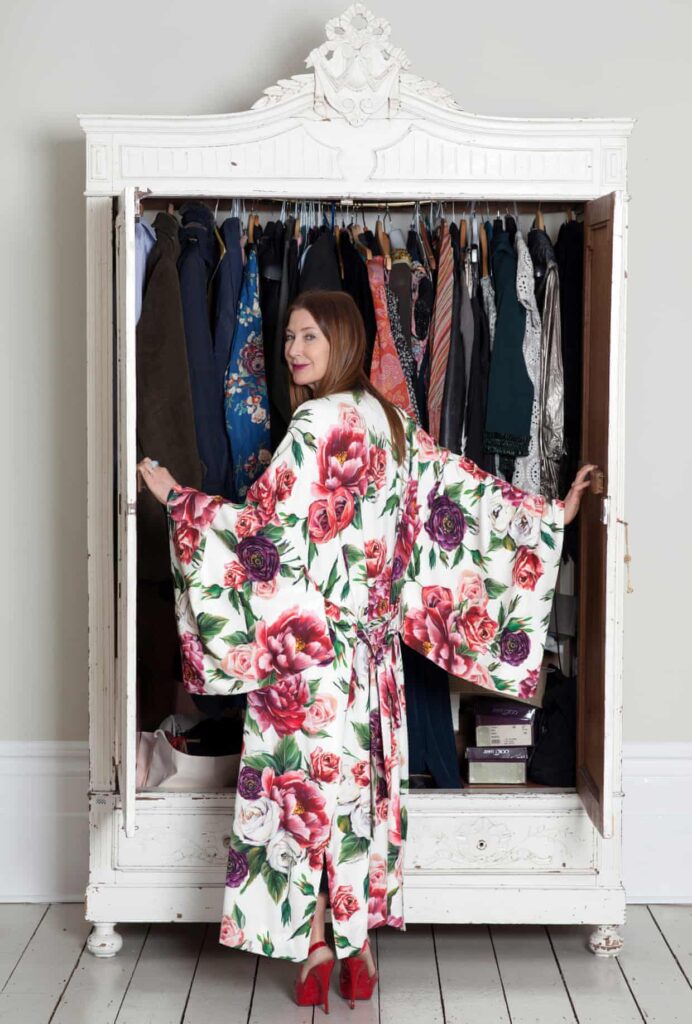
“You are that girl who wears bold colours, so I would actually have you wear those as that comes across better. It’s more authentic and people will feel it. That would make for a more successful meeting. The number one key to confidence is when you align your attire with your attitude,” she says.
The dreaded midlife makeover also gets short shrift. Karen thinks I have a “young energy”, which works with my 30-something wardrobe. “I would not have you throw away the clothes you bought in your 30s and 40s. That would be painstaking and exhausting, and a shock to the system. We’re not about casting away items that matter to you,” she says.
Rather than reining in my natural flamboyance, Karen is more interested in where my penchant for party frocks might have originated – my “fashion awakening” as she calls it in her book.
As I guide Karen through my outfits, unravelling my style story, it quickly becomes apparent that digging deep into my wardrobe is every bit as revealing as that classic analyst question: “So tell me about your mother.” Before I know it, I’m telling her a story about how, when I was nine, my father took me shopping for the first time, just before visiting my mother in hospital. He wanted to do something nice to cheer me up and the dress we bought was beautiful: deep, soft velvet, trailing the floor, hugely impractical and ruinously expensive. It delivered a kind of Ugly Duckling transformation, because in my sadness I’d also grown fat. I tried it on for my mum and that was the last time I saw her. She died later that month.
“That princess dress was your first introduction to how to deal with trauma, so that could have been the start of this whimsical brand you have now,” Karen ponders. “It could be that on an unconscious level you’re drawn to this kind of look.” Suddenly the abundance of lavish fabrics and dresses in my wardrobe doesn’t seems so flippant.
Even the tiny silver dress and an old leather mini skirt, both the size of a postage stamp, get to stay. “If an item holds psychological value or weight, you need to hold on to it,” she explains. “Traditional makeover people are all about throwing something away and putting on something new, but they’re not thinking about the psyche. These (too small) pieces are like ideal versions of ourselves. If we had longer, I would continue unravelling and unpacking.” No doubt this “unpacking” would turn up some unresolved issues around weight and body image.
Among her clients she has helped a dishevelled divorcee recover his self-esteem by using mindfulness as he got dressed in the morning. “Taking the time to pull his appearance together offered a tangible way to move through his crisis,” she explains. Another client came to her hoping to break out of her colour rut, as she always wore black and dark-grey clothing. “Once we started talking about her life we realised her attachment to dark colours began a decade earlier after her husband had died. I was surprised that she had never consciously made that connection before.” She was able to acknowledge her grief and her need for the dark clothes, but also started incorporating pops of colour into her wardrobe. And as for me, now I’ve understood my party dress addiction I can shop more mindfully and perhaps think twice before shopping in a crisis and reaching for yet another party-frock pick-me-up.
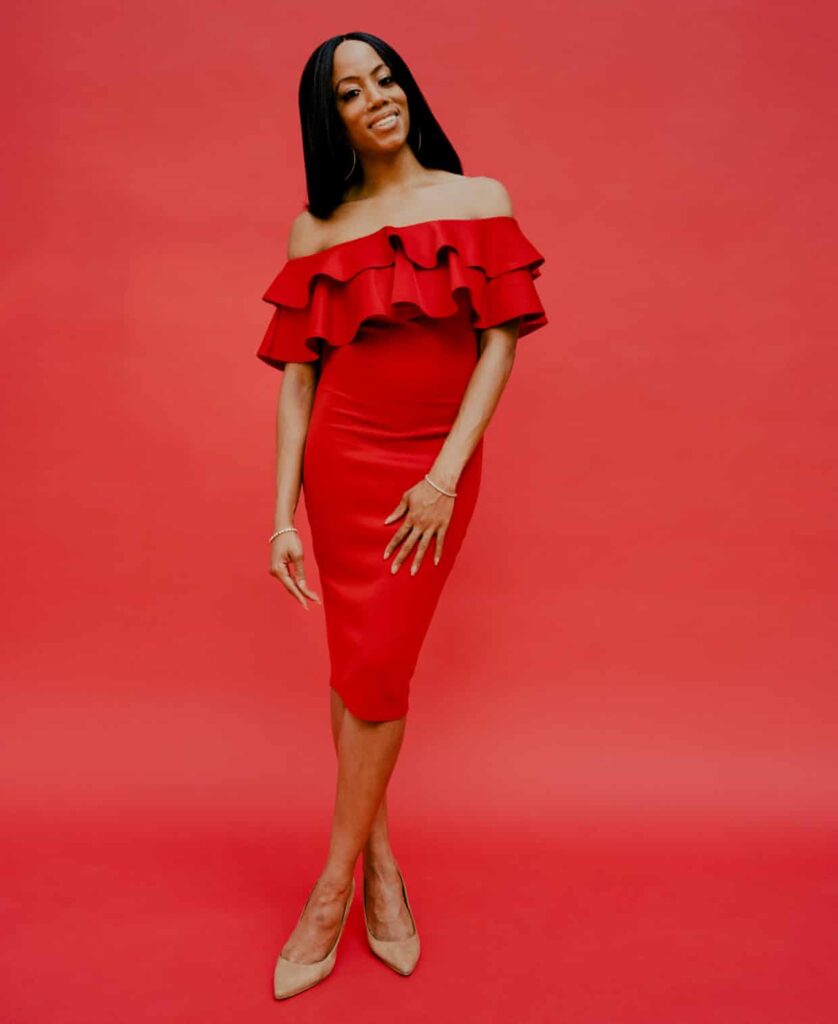
There’s no doubt that Karen’s hunch that clothes could be used as a form of therapy stems from her own history of using clothes to self-medicate. As a teen she loved fashion and hungrily absorbed her cousin’s designer-label castoffs, before finding her own style. But it was only later at college that everything changed. She was the victim of a sexual assault, and found herself traumatised, unable to eat or get out of bed. “I barely moved,” she writes in her book. “Then on Monday morning, I woke up and opened my closet.” Her chosen armour against the world and her feelings? “A body-skimming 1950s-style dress, reminiscent of Audrey Hepburn’s iconic Givenchy silhouettes.” She thinks of this episode now as a kind of power dressing. “I was dressing up my pain. I was shoring myself up to face the world. Dressing well was my first step to reclaiming my life.”
It wasn’t enough, of course – there’s only so far strappy sandals will take you when it comes to dealing with trauma of that magnitude, but the clothes got her to a place where she could talk about it. Eventually, she sought counselling and later defined her way of dressing to lift her mood as “Mood Enhancement Dressing”, which now forms a cornerstone of her therapy.
In our one-off therapy-cum-interview there’s no time to delve too deep, but in less than an hour I’ve seen first-hand how clothes can have huge emotional resonance. But what about that pile of clothes I need to wear within the week? The Radical Wardrobe Edit turns out not to be so radical after all. Karen’s main advice seems to be if a piece is “Blah, I don’t care”, bin it. But those that mean something will always have a place in your wardrobe.
Before we part, I have one last question for her. Could I, should I, still wear disco-ball frocks in my 70s? Could some version of that actually be OK? It might sound silly to you but, to me, this matters. After our session, I think I already know the answer, but I just want to hear her say it.
“I think we get too caught up in what’s age-appropriate,” she says. “You’ll make it work when the time comes. It doesn’t need to be fully sequined head-to-toe. You could take it down a notch, but the party frock will always be part of you.”
So the sequins stay. Hallelujah.
Wardrobe workout: Dawnn Karen’s six simple rules for stress-free dressing
- Less choice equals less stress. Do an expert closet edit, similar to an elimination diet for your wardrobe. Remove any item likely to cause upset, then slowly add it back in. Remember elegance is elimination, as said Cristóbal Balenciaga.
- Dress for your mood. Before you get dressed in the morning, ask how you’re feeling. Would you rather dress to perpetuate that mood (Mood Illustration Dressing) or to enhance it (Mood Enhancement Dressing)?
- Figure out your personal “brand” or trademark look. It can help to think of a celebrity style icon you’d like to emulate. Are you a Jo-Lo athleisure queen or a Jennifer Aniston classic minimalist?
- Reduce decision fatigue. Put together a Capsules Wardrobe – a limited number of key essentials that can be mixed and matched – and photograph your favourite outfits to remind you of the looks.
- There’s no shame in repeating outfits or having a style uniform (think Blue Obama suit or Steve Jobs turtleneck). Keira Knightley wore her wedding dress on the red carpet, twice. Or having set uniforms for different situations, like going to the airport.
- Don’t be a slave to trends or style rules. Dress for your personal “brand” or mood and don’t try to diminish yourself by wearing a style that doesn’t feel like you.
- Dress Your Best Life by Dawnn Karen is published by Penguin Life at £14.99. Order a copy for £12.59 at guardianbookshop.com

